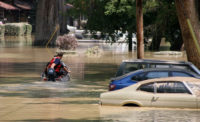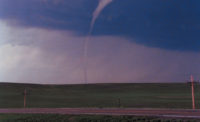National Disaster Preparedness Poll: Americans are More Concerned, Less Prepared for Future Crises

The fifth annual “National Domestic Preparedness Survey,” reveals that participants’ concern about some disasters has increased significantly. For example, concern about an emerging disease impacting communities quadrupled over 2019 numbers.
The findings, by Healthcare Ready, also revealed that less than half of those surveyed have an emergency plan in place or are likely to create one this year. Other key statistics reveal lack of preparedness behaviors become even more concerning when stratified by race and income. In 2020, black or low-income respondents were less likely to keep emergency supplies or a copy of their medical records on hand (and stored in a safe place) compared to other races or higher-income communities.
“Since our first survey in 2016, the US has faced unprecedented disasters. From Hurricane Maria, to the California Wildfires, to the COVID-19 pandemic, catastrophic events have impacted communities across the nation,” said Nicolette Louissaint, PhD, executive director of Healthcare Ready. “These disasters disproportionately affect the most vulnerable communities, and lack of preparedness further exacerbates adverse health outcomes. As we enter the 2020 Hurricane Season, these findings show that we must work to fight against these disparities by investing in preparedness initiatives at the community level to ensure communities can face the next disaster.”
Compared to findings from the 2018 poll, only 3% of respondents were most concerned about an emerging disease outbreak, and 10% were most concerned about an outbreak of a commonly occurring disease (e.g., influenza). The numbers remained consistent in 2019. However, in 2020, concern for outbreaks of emerging and common diseases rose to 19% and 12%, respectively. While the ongoing COVID-19 pandemic caused concern for disease outbreaks to increase, 25% of Americans still rank natural disasters as their greatest concern.
When stratified by geographic region, race and age group, the survey of 1,266 adults revealed statistically significant associations between these demographic factors and disasters of greatest concern. The Northeast is most concerned that an outbreak of an emerging disease (20%) and a commonly occurring disease (17%) will affect them. Whereas the South (34%), Midwest (22%) and West (21%) are most concerned that a natural disaster will affect their community.
Additionally, older Americans between 34-55 years (25%) and over 55 years (31%) are most concerned of a natural disaster. Younger adults between 18-34 years are most concerned of an outbreak of an exotic disease (19%).
“These findings show how important it is to have the resources in place to prepare their communities well in advance in order to be able to respond to several types of emergencies at once,” said Louissaint. “If the current pandemic has taught us anything, it is that we must be proactive at the local, state, and national level so that we can react to all kinds of emergency situations quickly and efficiently. This poll helps us determine which vulnerable groups we need to support the most.”
This year’s survey was conducted in May during the country’s height of the COVID-19 pandemic and included the following insights:
- Sixty-five percent of Americans think a major disaster is likely to impact them or their family in the next five years, an increase from 54% in 2019. However, 50% do not have an emergency plan in place.
- The South had the highest proportion of respondents who believe it is likely that a major disaster will impact their community (73%). The Midwest had the lowest proportion (56%). (Note: statistically significant)
- Americans are less aware of their medical information in 2020 compared to 2019. Thirty-seven percent said they could list all their medical information, including the type of prescription, the doctor who prescribed them, and the dose. This is a slight decrease from 40% in 2019.
- Older respondents were most aware of their medical information. Forty-nine percent of those 55+ years, 33% of those 34-55 years and 23% of those 18-34 years can list all information related to their medications or medical devices. (Note: statistically significant)
- Thirty-seven percent of Americans can only go one week without their prescribed medications or medical devices before facing a personal medical crisis.
- Older respondents could go the least amount of time without their prescription medicines. Forty-two percent of those aged 55+, 37% of those aged 34-55, and 30% of those aged 18-34 could not go longer than a week without their medicines.
- Respondents in the lowest income bracket could go the least amount of time without their prescription medicines. Forty-four percent of those who make under $40,000 per year could not go longer than a week without their medicines. Comparatively, 31% of those who make over $80,000 per year could not go longer than a week without their medicines.
- Only 34% of Americans believe that local community organizations are prepared and resourced to assist their community in the wake of an emergency.
- The South (36%) and the Northeast (36%) were most likely to agree that local community organizations have the resources they need to assist community member during an emergency and the Midwest was least likely (31%).
The 2020 survey also highlighted clear disparities between the preparedness behaviors of those with higher levels of education than those with lower levels. Respondents with at most a high school education are least likely to have a bag packed with emergency supplies in their house (24%) and a copy of their medical history in a safe place (35%) compared to respondents with higher levels of education.
Respondents in the highest income bracket (more than $80k per year) are most likely to have a bag packed with emergency supplies in their house (34%) and a copy of their medical history in a safe place (41%) compared to respondents in the lower income brackets.
Across the nation, Americans are more likely to keep cash on hand (47%) than emergency supplies (29%) or their medical records (37%).
Respondents in the highest income bracket (more than $80k per year) are most likely to keep cash on-hand (55%). Comparatively, 49% of respondents who earn $40k - $80k per year and 42% of respondents who earn less than $40k per year report keeping cash on-hand for an emergency.
Looking for a reprint of this article?
From high-res PDFs to custom plaques, order your copy today!





